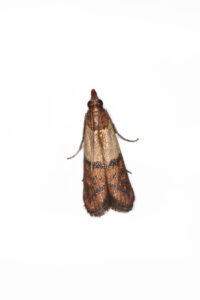Our treatment against food moths
Food moth infestations can render entire batches of nuts unsellable. At Steripure, we offer a radical and controlled treatment to address food moths infestations and make your batches marketable
A single moth can lay up to 50 eggs per day and deposit 400 eggs directly onto your products in just one to two weeks. With rising temperatures, the risk of infestation skyrockets in your product stocks.
What treatment is effective against food moths?
Steripure offers a decontamination treatment using saturated steam that completely eliminates food moth infestations. With this solution, your batches can be marketed again.
How does it work?
Steripure uses saturated steam under vacuum to treat products. This process eradicates infestations while reducing the bacterial load of infested products. It eliminates moths at all development stages: eggs, larvae, and insects.
Logistics designed to prevent food moth infestations
Unlike other productions where we receive pallets 48 hours in advance, these pallets are delivered just a few hours before production begins. This approach minimizes the risk of insect spread due to extended storage. Additionally, upon arrival, we immediately shrink-wrap the pallets to ensure the safety of other products.
The advantages of our process for your nuts:
- 100% natural process: Unlike fumigation, which disperses a chemical compound, we use water steam — an organic-certified process.
- Total eradication: The treatment eliminates eggs, larvae, and insects to the core of the products.
- Zero residue: Thanks to the power of our process, moths are literally disintegrated. No residue remains in the products.
Saturated steam vs fumigation: what treatment can eradicate food moth treatment?
| Criteria | Saturated Steam | Fumigation |
|---|---|---|
| Nature of treatment | 100% natural (no chemicals) | Chemical (gas or active substances) |
| Residues on products | No residue | Risk of fumigant residues in food |
| Effectiveness on moths | Highly effective (eggs, larvae, adults) | Less effective on eggs and larvae |
| Impact on product quality | Quality preserved | May alter some products, quality and odor |
| Eco-responsibility | Low environmental impact | Higher environmental impact |
| Resistance | No resistance due to control of time, pressure, and temperature | Some insects develop resistance to fumigants, reducing effectiveness |
| Depth of action | Penetrates deep into the core, ensuring full decontamination | Treatment on entire pallets, mainly surface-level and surrounding |
How to identify a food moth?
-
Adult: Small moth, 8 to 10 mm long, with bicolored wings (grey and brown/coppery).
-
Larva: Whitish caterpillar up to 12 mm long, often visible in infested products.
-
Signs of infestation: Silk threads, webs inside packaging, clumped product, presence of flying moths, live larvae or dead insects.

Main types of food moths:
-
Plodia interpunctella (Indian meal moth): The most common species, it infests nuts, cereals, dried fruits, and seeds.
-
Ephestia kuehniella (Mediterranean flour moth): Common in flour, cereals, dried fruits, and seeds.
-
Ephestia cautella (Tropical warehouse moth): Affects a wide variety of dry goods, including dried fruits and spices.

